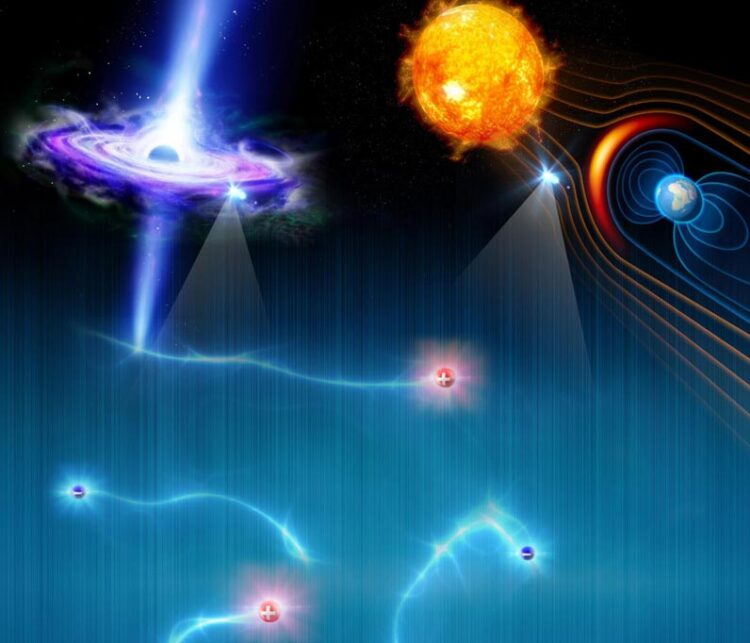Compressive fluctuations heat ions in space plasma

Artist's impression of the ions and electrons in various space plasmas.
Credit: Yohei Kawazura
New simulations carried out in part on the ATERUI II supercomputer in Japan have found that the reason ions exist at higher temperatures than electrons in space plasma is because they are better able to absorb energy from compressive turbulent fluctuations in the plasma. These finding have important implications for understanding observations of various astronomical objects such as the images of the accretion disk and shadow of the M87 supermassive black hole captured by the Event Horizon Telescope.
In addition to the normal three states of matter (solid, liquid, and gas) which we see around us every day, there is an additional state called plasma which exists only at high temperatures. Under these conditions, electrons become separated from their parent atoms leaving behind positively charged ions. In space plasma the electrons and ions rarely collide with each other, meaning that they can coexist in different conditions, such as at different temperatures. However, there is no obvious reason why they should have different temperatures unless some force affects them differently. So why ions are usually hotter than electrons in space plasma has long been a mystery.
One way to heat plasma is by turbulence. Chaotic fluctuations in turbulence smoothly mix with particles, and then their energy is converted into heat. To determine the roles of different types of fluctuations in plasma heating, an international team led by Yohei Kawazura at Tohoku University in Japan performed the world’s first simulations of space plasma including two types of fluctuations, transverse oscillations of magnetic field lines and longitudinal oscillations of pressure. They used nonlinear hybrid gyrokinetic simulations which are particularly good at modeling slow fluctuations. These simulations were conducted on several supercomputers, including ATERUI II at the National Astronomical Observatory of Japan.
The results showed that the longitudinal fluctuations like to mix with ions but leave electrons. On the other hand the transverse fluctuations can mix with both ions and electrons. “Surprisingly, the longitudinal fluctuations are picky about the partner species to mix with,” says Kawazura. This is a key result for understanding the ion to electron heating ratios in plasmas observed in space, like that around the supermassive black hole in Galaxy M87.
###
These results appeared as Y. Kawazura et al. “Ion versus Electron Heating in Compressively Driven Astrophysical Gyrokinetic Turbulence” in Physical Review X, on December 11, 2020.
All latest news from the category: Physics and Astronomy
This area deals with the fundamental laws and building blocks of nature and how they interact, the properties and the behavior of matter, and research into space and time and their structures.
innovations-report provides in-depth reports and articles on subjects such as astrophysics, laser technologies, nuclear, quantum, particle and solid-state physics, nanotechnologies, planetary research and findings (Mars, Venus) and developments related to the Hubble Telescope.
Newest articles

Hubble Views the Dawn of a Sun-like Star
Looking like a glittering cosmic geode, a trio of dazzling stars blaze from the hollowed-out cavity of a reflection nebula in this new image from NASA’s Hubble Space Telescope. The…

Engineering a new color palette for single-molecule imaging
A new paper published in Nature Nanotechnology outlines a way to create dozens of new “colors” to multiplex single-molecule measurements. Researchers often study biomolecules such as proteins or amino acids…

Using solar energy to generate heat at high temperatures
The production of cement, metals and many chemical commodities requires extremely high temperatures of over a thousand degrees Celsius. At present, this heat is usually obtained by combusting fossil fuels:…





















